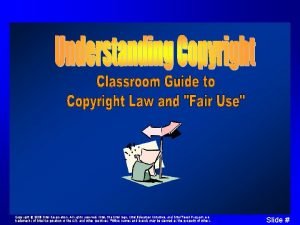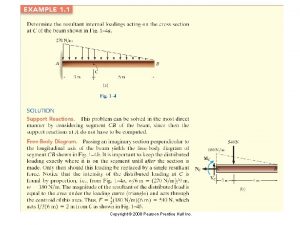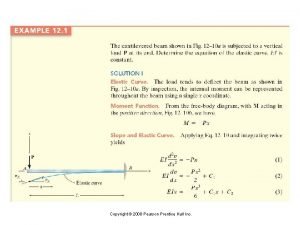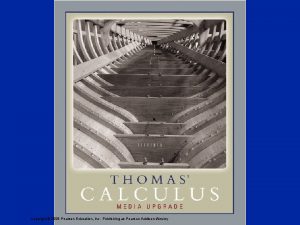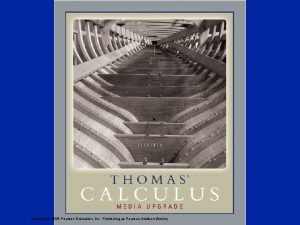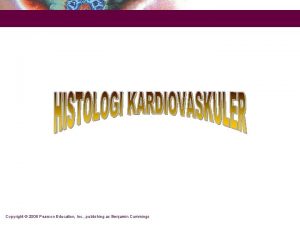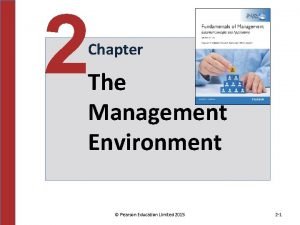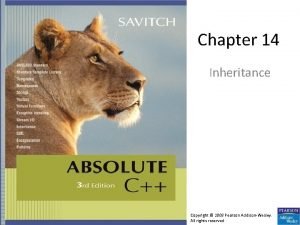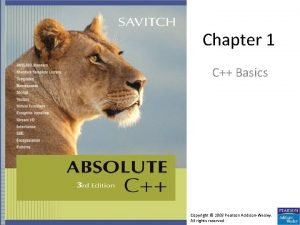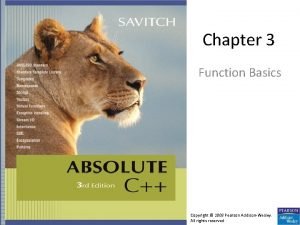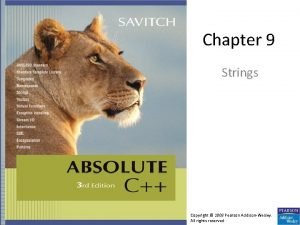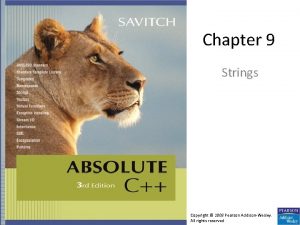Chapter 18 Social Insurance Copyright 2008 Pearson AddisonWesley











































- Slides: 43

Chapter 18 Social Insurance Copyright © 2008 Pearson Addison-Wesley. All rights reserved.

Agenda • Social Insurance Basics • Old-Age, Survivors, and Disability Insurance (OASDI) • Medicare • Unemployment Insurance • Workers Compensation Copyright © 2008 Pearson Addison-Wesley. All rights reserved. 2

Reasons for Social Insurance • Social insurance programs are necessary for several reasons: – To help solve complex social problems – To provide coverage for perils that are difficult to insure privately – To provide a base of economic security to the population Copyright © 2008 Pearson Addison-Wesley. All rights reserved. 3

Basic Characteristics of Social Insurance • Social insurance programs have certain characteristics that distinguish them from other government insurance programs: – Most programs are compulsory • This makes it easier to provide a floor of income to the population • It also reduces adverse selection – Programs are designed to provide a floor of income – Programs pay benefits based largely on social adequacy rather than individual equity • The benefits are heavily weighted in favor of certain groups, such as low -income persons, large families, and retirees Copyright © 2008 Pearson Addison-Wesley. All rights reserved. 4

Basic Characteristics of Social Insurance – Benefits are loosely related to the workers’ earnings – Programs, benefits, and benefit formulas are prescribed by law – A formal means test is not required • A means test involves disclosing income and assets – Full funding of benefits is unnecessary • For example, it is not necessary to fully fund Social Security because workers will always enter the program and support it – Programs are designed to be financially self-supporting • Programs should be almost completely financed from the earmarked contributions of covered employees Copyright © 2008 Pearson Addison-Wesley. All rights reserved. 5

Old-Age, Survivors, and Disability Insurance (OASDI) • Commonly known as Social Security, OASDI is the most important social insurance program in the US – Enacted in 1935, it covers more than 9 out of 10 workers • Groups covered under the Social Security Program include: – – – Employees in private firms Federal civilian employees State and local government employees Employees of nonprofit organizations Self-employed persons who earn $400/year or more Domestic employees in private homes who earn $1500/year or more (in 2006) – Miscellaneous other groups, including ministers, US military personnel, and railroad workers Copyright © 2008 Pearson Addison-Wesley. All rights reserved. 6

Old-Age, Survivors, and Disability Insurance (OASDI) • A worker becomes eligible for benefits by attaining an insured status: – To attain a fully insured status, a worker must have 40 credits • In 2006, a credit is earned for each $970 of covered earnings • A maximum of 4 credits can be earned each year – You are currently insured if you have earned at least 6 credits in the past 13 calendar quarters – The number of credits required to be disability insured depends on the age when you become disabled – Eligibility for certain benefits depends on insured status: • Fully insured: retirement and survivor benefits • Currently insured: survivor benefits • Disability insured: disability benefits Copyright © 2008 Pearson Addison-Wesley. All rights reserved. 7

OASDI: Retirement Benefits • Social security retirement benefits are an important source of income for most retired workers – Full retirement age for unreduced benefits is age 65, but will gradually increase to 67 – Workers and their spouses can retire at age 62 with actuarially reduced benefits • More than half of the OASDI beneficiaries apply for retirement benefits before the full retirement age – Monthly retirement benefits can be paid to retired workers and their dependents Copyright © 2008 Pearson Addison-Wesley. All rights reserved. 8

Exhibit 18. 1 Social Security Full Retirement Age and Reduction in Benefits by Age Copyright © 2008 Pearson Addison-Wesley. All rights reserved. 9

OASDI: Retirement Benefits • The monthly retirement benefit is based on the worker’s primary insurance amount (PIA) – The PIA is based on the worker’s average indexed monthly earnings (AIME) • Indexing results in a relatively constant replacement rate so that workers retiring today and in the future will have about the same proportion of their work earnings replaced by OASDI benefits • The AIME is based on a weighted benefit formula which weights the benefits heavily in favor of low-income groups Copyright © 2008 Pearson Addison-Wesley. All rights reserved. 10

Exhibit 18. 2 Examples of Monthly OASDI Retirement Benefits at the Full Retirement Age (FRA) Copyright © 2008 Pearson Addison-Wesley. All rights reserved. 11

OASDI: Retirement Benefits • A delayed retirement credit is available if you delay receiving retirement benefits beyond the full retirement age • Cash benefits are automatically adjusted each year for changes in the cost of living • The program has an earnings test that can result in a reduction or loss of monthly benefits for workers with earned incomes above certain annual limits – Beneficiaries who have attained the full retirement age or beyond can earn any amount and receive full OASDI benefits – To encourage private savings and investments to supplement the benefits, the earnings test does not apply to investment income, dividends, interest, rents or annuity payments Copyright © 2008 Pearson Addison-Wesley. All rights reserved. 12

OASDI: Survivor Benefits • Survivor benefits can be paid to the dependents of a deceased worker who is either fully or currently insured – The benefits provide a substantial amount of financial protection to families • For the average family, the benefits are equal to a $354, 000 life insurance policy Copyright © 2008 Pearson Addison-Wesley. All rights reserved. 13

OASDI: Disability Benefits • Disability benefits can be paid to disabled workers who meet certain eligibility requirements – The benefits provide protection against the loss of income during a long-term disability • For the average family, disability payments are equivalent to a private disability insurance policy worth over $233, 000 – The worker must meet a five-month waiting period, and satisfy the definition of disability • The worker must have a physical or mental condition that prevents him or her from doing any substantial gainful activity and is expected to last at least 12 months or is expected to result in death Copyright © 2008 Pearson Addison-Wesley. All rights reserved. 14

OASDI: Disability Benefits • Major groups eligible to receive OASDI disability benefits include: – A disabled worker under the full retirement age – The spouse of a disabled worker – Unmarried children of the disabled worker, if under age 18 – Unmarried children age 18 or older who become severely disabled before age 22 Copyright © 2008 Pearson Addison-Wesley. All rights reserved. 15

Taxation and Financing of OASDI Benefits • Some beneficiaries who receive monthly cash benefits must pay an income tax on part of the benefits – The amount depends on the level of your combined income, which is the sum of your adjusted gross income, tax-free interest, and ½ of your Social Security benefits • Social Security benefits are financed by a payroll tax paid by employees, employers, and the selfemployed – In 2006, a worker paid a payroll tax of 6. 2% on covered earnings up to a maximum of $94, 200 Copyright © 2008 Pearson Addison-Wesley. All rights reserved. 16

Long-range OASDI Actuarial Deficit • The present program is running an annual surplus, but the OASDI trust funds will experience serious financial problems in the future – Projected OASDI tax income will begin to fall short of outlays in 2017 – The program can be actuarially balanced over the next 75 years in various ways, including: • • An immediate increase of 16% in payroll tax revenues An immediate reduction in benefits of 13% Using general revenues of the federal government to pay benefits Or, some combination of these options – One proposal would create voluntary personal retirement accounts, allowing workers to divert two full percentage points from the OASDI payroll tax into voluntary personal retirement accounts Copyright © 2008 Pearson Addison-Wesley. All rights reserved. 17

Medicare • Medicare covers the medical expenses of most persons age 65 and older • The program also includes prescription drug plans and health care plans of private insurers • Beneficiaries can select among an array of plans including: – – The original Medicare plan Medicare Advantage plans Other Medicare health plans Medicare prescription drug plans Copyright © 2008 Pearson Addison-Wesley. All rights reserved. 18

Medicare • Under the original Medicare plan: – Beneficiaries can elect any provider that accepts Medicare patients – Medicare pays its share of the bill, and the beneficiary pays the balance • The original program provides benefits in two parts: – Hospital Insurance (Part A) provides coverage for inpatient hospital stays and other services including skilled nursing facility care, home health care, hospice care, and blood transfusions • Hospitals are reimbursed for inpatient services under a prospective payment system – A flat amount is paid for each service based on its diagnosis-related group (DRG) Copyright © 2008 Pearson Addison-Wesley. All rights reserved. 19

Medicare – Medical Insurance (Part B) is a voluntary program that covers physicians’ fees and related medical services • Covered services include physician services, clinical laboratory services, home health care, outpatient hospital services, and blood • Beneficiaries must pay a monthly premium for the benefits – Currently beneficiaries with annual incomes under certain levels pay 25% of the cost of the program, and the federal government pays the rest – A means test will be applied beginning in 2007 • The beneficiary must meet an annual Part B deductible • The program pays 80% of the Medicare-approved amount for most physician services, outpatient therapy, preventive services and durable medical equipment • Payments to physicians are made on an assigned or nonassigned basis Copyright © 2008 Pearson Addison-Wesley. All rights reserved. 20

Medicare • Medicare hospital insurance (Part A) is financed by a payroll tax paid by covered employees, employers, and the self-employed – The program is subsidized by a small amount of general revenues • Medical insurance (Part B) is financed by monthly premiums and the general revenues of the federal government • Medicare Part A has serious financial problems – The projected 75 -year actuarial deficit in the Hospital Insurance Trust Fund is 3. 51% of taxable payroll – The fund is expected to be exhausted by 2018 Copyright © 2008 Pearson Addison-Wesley. All rights reserved. 21

Medicare • Medicare Advantage Plans (Part C) are private health plans that are part of the Medicare program – If beneficiaries choose this alternative, Medicare pays a set monthly amount to the private plan – Most plans provide extra benefits and have lower co-payments than the original Medicare plan – Plans include: • • Medicare HMOs Medicare PPOs Medicare Special Needs plans Medicare Private Fee-for-service plans Copyright © 2008 Pearson Addison-Wesley. All rights reserved. 22

Medicare – Medicare HMOs are managed care plans operated by private insurers • The plan may require members to choose a primary care physician and get a referral to see a specialist • If the plan covers prescription drugs, members must pay a co-payment or coinsurance charge for each covered prescription – Under a Medicare PPO, beneficiaries can generally see any doctor or provider that accepts Medicare patients • Members do not need a referral from a primary care doctor to see a specialist – A Medicare Special Needs plan provides more focused care for specific groups of people, such as those with chronic illnesses – Under a Medicare Private Fee-for-service plan, the private company, rather than Medicare, decides how much it will pay and the amounts members must pay for the services provided Copyright © 2008 Pearson Addison-Wesley. All rights reserved. 23

Medicare • Medicare beneficiaries have other choices for coverage besides the Advantage Plans – Under a Medicare Cost plan, members receive care from primary care doctors and hospitals that are part of the network • Services obtained outside the network are covered under the original Medicare plan, but members must pay the Part A and Part B coinsurance and deductibles – A PACE program combines medical, social, and longterm care services for the frail elderly Copyright © 2008 Pearson Addison-Wesley. All rights reserved. 24

Medicare Prescription Drug Plans • Medicare prescription drug coverage (Part D) is a relatively new benefit, available to all beneficiaries – Beneficiaries in the original Medicare plan can add prescription drug coverage by joining a stand-alone plan • Monthly premiums depend on the specific plan chosen • Plans must provide at least standard coverage – Beneficiaries pay part of the cost of prescription drugs, and Medicare pays part of the cost • The cost sharing provisions are complex • Costs are reduced for low-income beneficiaries Copyright © 2008 Pearson Addison-Wesley. All rights reserved. 25

Exhibit 18. 3 Example of Cost-Sharing Provisions Under Medicare Prescription Drug Coverage (2007) Copyright © 2008 Pearson Addison-Wesley. All rights reserved. 26

Medicare Prescription Drug Plans • The new law contains several other provisions: – The potential for importing drugs from foreign countries is under consideration – The federal government is prohibited from using its purchasing power to negotiate lower prices with pharmaceutical companies – Private firms will administer the program on a regional basis – Under a demonstration project, the original Medicare plan will face competition from private plans beginning in 2010 Copyright © 2008 Pearson Addison-Wesley. All rights reserved. 27

Medigap • Medicare beneficiaries can purchase a Medigap policy to cover part or all of medical expenses not paid by Medicare – The policies are sold by private insurers, and are strictly regulated by federal law – There are 12 plans (A-L) which offer different sets of benefits Copyright © 2008 Pearson Addison-Wesley. All rights reserved. 28

Unemployment Insurance • The federal and state governments provide unemployment insurance – Programs pay weekly cash benefits to workers who are involuntarily unemployed – Cash benefits are paid during periods of short-term involuntary unemployment – Applicants are encouraged through local employment offices to seek employment – Unemployment benefits help stabilize the economy during recessionary periods Copyright © 2008 Pearson Addison-Wesley. All rights reserved. 29

Unemployment Insurance • Most private firms, state and local governments, and nonprofit organizations are covered for unemployment benefits – Private firms are subject to the federal unemployment tax • To be eligible, an unemployed worker must: – Have qualifying wages and employment during the base year – Be able and available for work – Be actively seeking work – Be free from disqualification – Serve a one-week waiting period Copyright © 2008 Pearson Addison-Wesley. All rights reserved. 30

Unemployment Insurance • Benefits paid depend on the worker’s past wages, within certain limits – Most states use a formula and pay a fraction of the worker’s high quarter wages – The maximum duration of regular benefits is limited to 26 weeks in most states • Under the extended-benefits program, an additional 13 weeks of benefits is paid during periods of high unemployment • Programs are financed largely by payroll taxes paid by employers on the covered wages of employees – For 2006, covered employers paid a federal payroll tax of 6. 2% on the first $7000 of annual wages – Experience rating is also used, by which firms with favorable employment records pay reduced tax rates Copyright © 2008 Pearson Addison-Wesley. All rights reserved. 31

Unemployment Insurance • State unemployment insurance programs face numerous problems: – Only a small proportion of the total unemployed receive benefits • Reasons include tighter eligibility requirements – Many states have low trust fund balances for paying benefits – A high percentage of claimants exhaust their benefits during business recessions Copyright © 2008 Pearson Addison-Wesley. All rights reserved. 32

Exhibit 18. 4 Insured Unemployment as a Percent of Total Employment: Regular State Programs Copyright © 2008 Pearson Addison-Wesley. All rights reserved. 33

Exhibit 18. 5 Average High Cost Multiple, by State (calendar year 2003) Copyright © 2008 Pearson Addison-Wesley. All rights reserved. 34

Exhibit 18. 6 Exhaustion Rates: Proportion of Claimants Who Collect Their Full Entitlement to State Unemployment Insurance Benefits Copyright © 2008 Pearson Addison-Wesley. All rights reserved. 35

Workers Compensation • Workers compensation is a social insurance program that provides medical care, cash benefits, and rehabilitation services to workers who are disabled from job-related accidents or disease • Under the common law of industrial accidents (1837), workers injured on the job had to sue their employers and prove negligence before they could collect damages – Under the contributory negligence doctrine, injured workers could not collect damages if they contributed in any way to the injury – Under the fellow-servant doctrine, the injured worker could not collect damages if the injury resulted from the negligence of a fellow worker – Under the assumption-of-risk doctrine, the injured worker could not collect if he or she had advanced knowledge of the dangers of the occupation Copyright © 2008 Pearson Addison-Wesley. All rights reserved. 36

Workers Compensation • The enactment of employer liability laws between 1885 and 1910 improved the legal position of injured workers – But, workers still had to sue their employers to collect for their injuries • Most states passed workers compensation laws by 1920 – Workers compensation is based on the fundamental principle of liability without fault; the employer is held absolutely liable for jobrelated injuries or diseases suffered by the workers, regardless of who is at fault – Employees do not have to sue their employers Copyright © 2008 Pearson Addison-Wesley. All rights reserved. 37

Workers Compensation • Objectives of state workers compensation laws include: – To provide broad coverage of employees for job-related accidents and disease – To provide substantial protection against the loss of income – To provide sufficient medical care and rehabilitation services to injured workers – To encourage firms to reduce job-related accidents – To reduce litigation Copyright © 2008 Pearson Addison-Wesley. All rights reserved. 38

Workers Compensation • Workers compensation laws provide four benefits: – Medical care generally is covered in full with no limitations – Disability-income benefits can be paid after the disabled worker satisfies a waiting period – Death benefits can be paid to eligible survivors if the worker dies as a result of a job-related accident or disease – All states provide rehabilitation services to restore disabled workers to productive employment Copyright © 2008 Pearson Addison-Wesley. All rights reserved. 39

Workers Compensation • State workers compensation programs face numerous problems: – Insurers face the continued risk of terrorist attacks – Claim costs continue to increase due to the rising cost of medical care – Attorney involvement in workers compensation claims increases claims costs by 12 -15 percent • Court decisions have eroded the exclusive remedy doctrine, which states that workers compensation benefits should be the sole and exclusive remedy for injured workers Copyright © 2008 Pearson Addison-Wesley. All rights reserved. 40

Exhibit 18. 7 Workers Compensation Average Claim Cost, Medical vs. Indemnity, 1994 and 2004 Copyright © 2008 Pearson Addison-Wesley. All rights reserved. 41

Insight 18. 1 When Is the Right Time to Draw Social Security? Copyright © 2008 Pearson Addison-Wesley. All rights reserved. 42

Insight 18. 2 Proposed Changes in Social Security—Estimated Impact on Long-Range Actuarial Deficit Copyright © 2008 Pearson Addison-Wesley. All rights reserved. 43
 2008 2008
2008 2008 Copyright 2008
Copyright 2008 Copyright 2008
Copyright 2008 Copyright 2008
Copyright 2008 Redistribution prohibited
Redistribution prohibited Pearson education inc publishing as pearson prentice hall
Pearson education inc publishing as pearson prentice hall Copyright 2008
Copyright 2008 Copyright 2008
Copyright 2008 Pearson education limited 2008
Pearson education limited 2008 2008 pearson prentice hall inc
2008 pearson prentice hall inc 2008 pearson prentice hall inc
2008 pearson prentice hall inc Pearson
Pearson 2008 pearson education inc
2008 pearson education inc Copyright 2003 pearson education inc
Copyright 2003 pearson education inc Pearson education limited 2008
Pearson education limited 2008 Pearson education limited 2008
Pearson education limited 2008 What is line item budget
What is line item budget 2008 pearson education inc
2008 pearson education inc 2008 pearson education inc
2008 pearson education inc Pearson
Pearson 2008 pearson education inc
2008 pearson education inc Pearson education publishing as benjamin cummings
Pearson education publishing as benjamin cummings Pearson education limited 2015
Pearson education limited 2015 2017 pearson education inc
2017 pearson education inc Copyright by pearson education inc. answers
Copyright by pearson education inc. answers Copyright 2010 pearson education inc
Copyright 2010 pearson education inc 2009 pearson education inc
2009 pearson education inc Copyright pearson education inc
Copyright pearson education inc 2014 pearson education inc
2014 pearson education inc Copyright 2010 pearson education inc
Copyright 2010 pearson education inc Copyright 2010 pearson education inc
Copyright 2010 pearson education inc Copyright by pearson education inc. answers
Copyright by pearson education inc. answers Copyright 2005 pearson prentice hall inc
Copyright 2005 pearson prentice hall inc Copyright 2009 pearson education inc
Copyright 2009 pearson education inc Copyright pearson education inc
Copyright pearson education inc Copyright 2010 pearson education inc
Copyright 2010 pearson education inc Copyright 2010 pearson education inc
Copyright 2010 pearson education inc Copyright 2010 pearson education inc
Copyright 2010 pearson education inc Copyright 2010 pearson education inc
Copyright 2010 pearson education inc Copyright 2010 pearson education inc
Copyright 2010 pearson education inc Copyright 2010 pearson education inc
Copyright 2010 pearson education inc Pearson education inc all rights reserved
Pearson education inc all rights reserved Copyright 2009 pearson education inc
Copyright 2009 pearson education inc Copyright 2009 pearson education inc
Copyright 2009 pearson education inc


